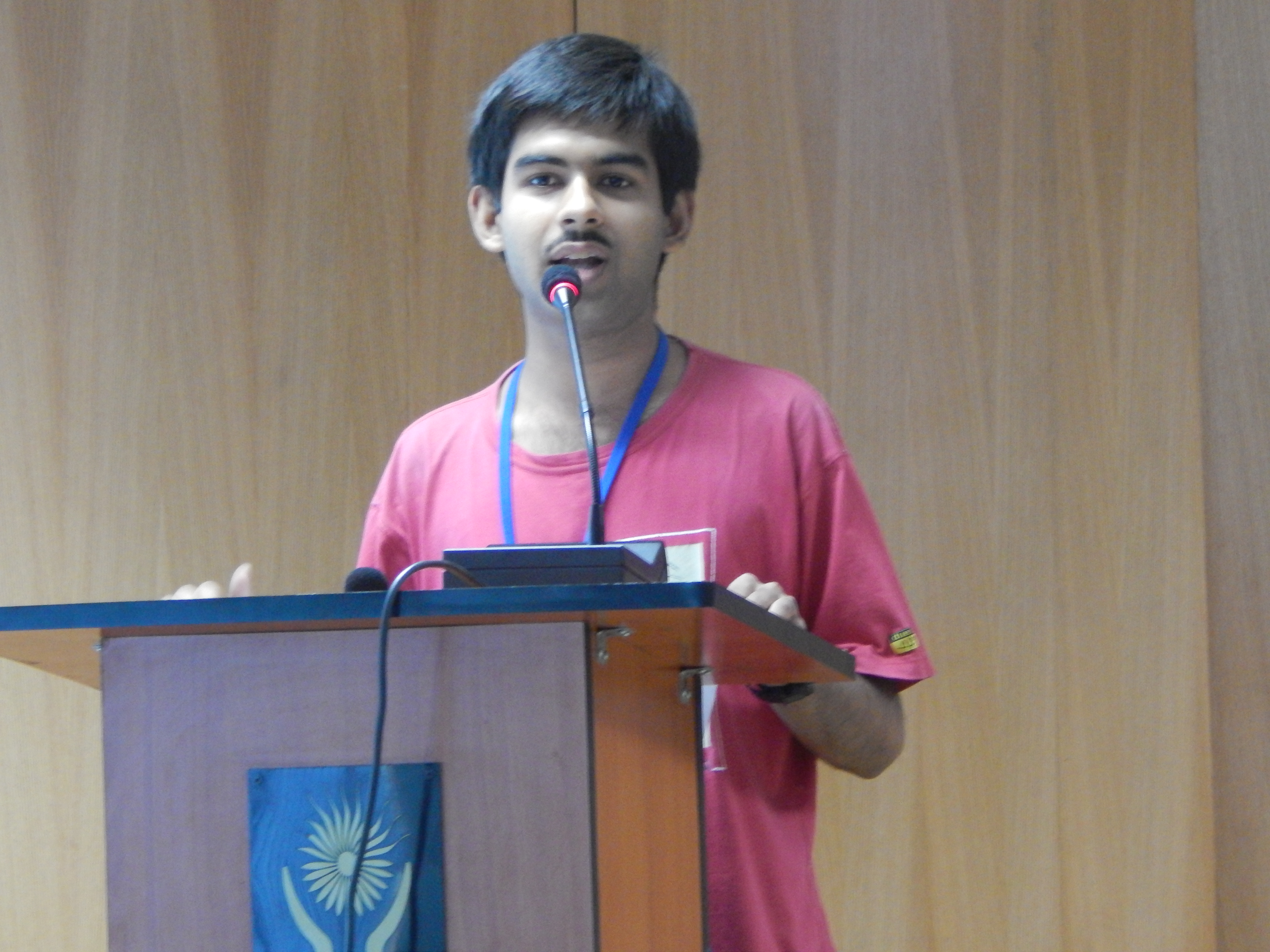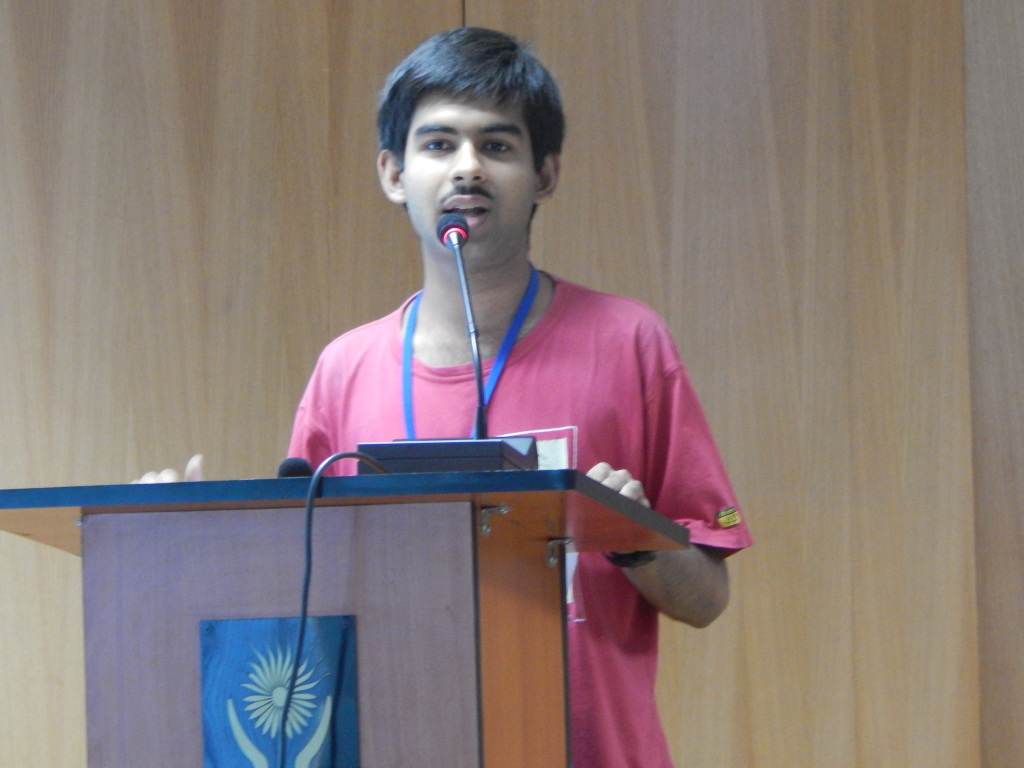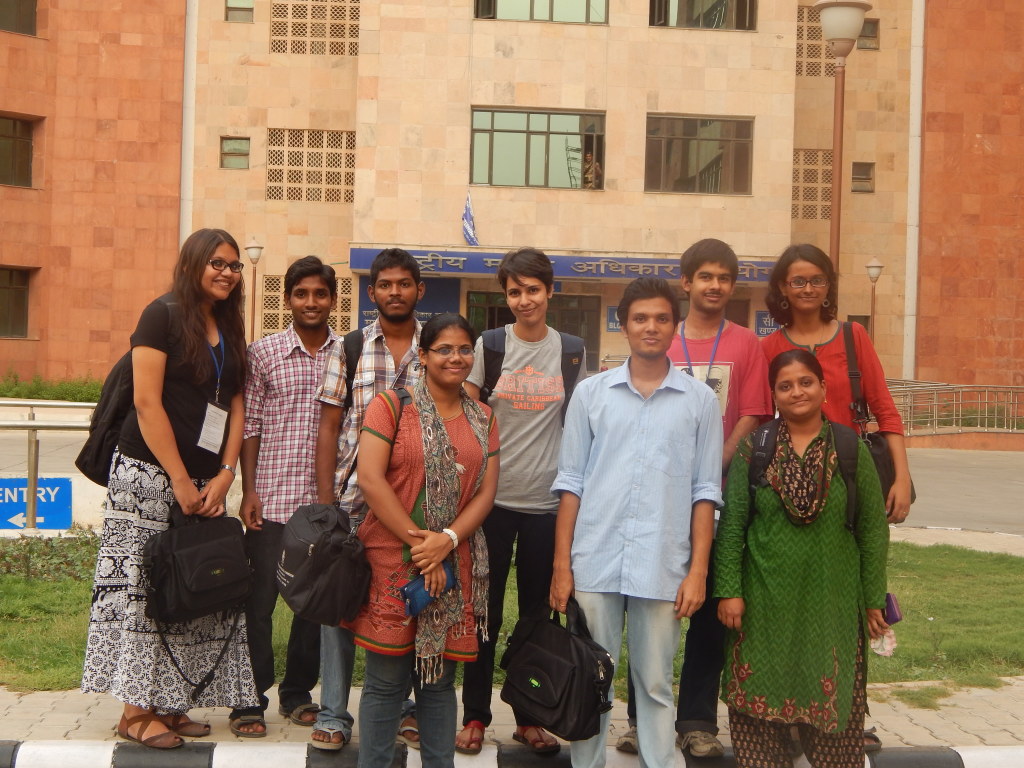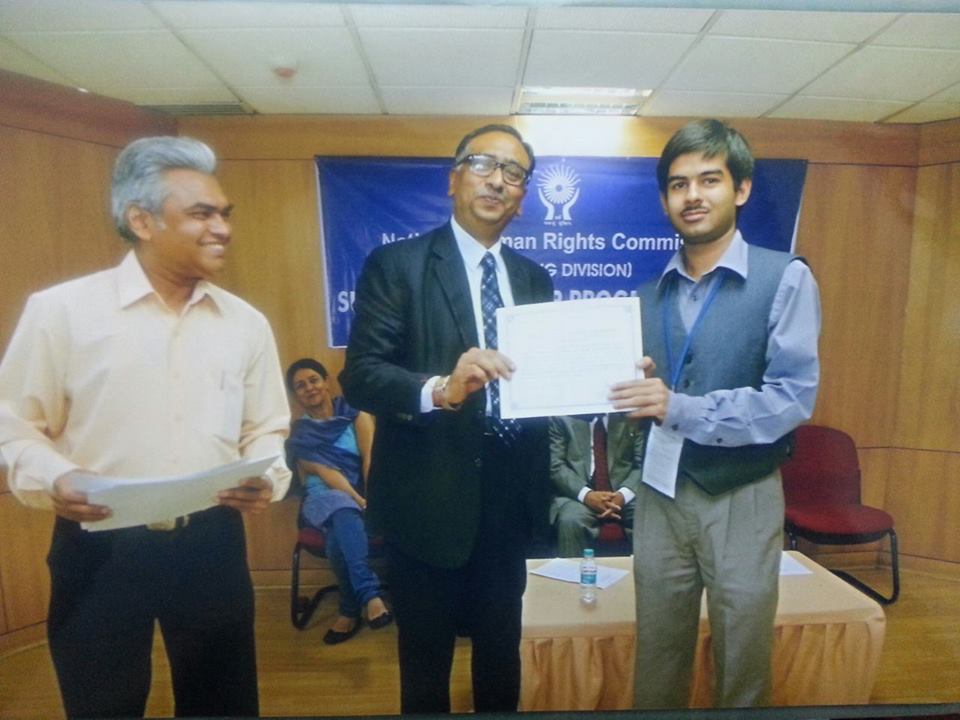This experience was shared by Sumit Kumar Ganguly of National Law University, Jodhpur.
I had interned at the National Human Rights Commission in their Summer Internship Programme-2014. The internship programme is a mandate under Section 12(h) of the Protection of Human Rights Act, 1993 under which the National Human Rights Commission is supposed to promote Human Rights literacy and awareness. The internship offer is not limited only to law students, it is also available to students pursuing Master’s degree in any branch of social sciences. Also, the internship policy is to give representation to all categories of students. This time, the internship programmme was during the period of 2nd June, 2014 to 1st July, 2014. Two interesting facts deserve mention here. Firstly, the number of female interns was more than the male interns. There were 37 girls and only 13 boys out of the total 50 interns. Secondly, the number of non-law students was more than law students. There were 20 law students and 30 non-law students. Out of the non-law students, there was diversity. There were students pursuing Sociology, Political Science, Economics, International Relations, Social Work, Anthropology, Criminology, Development and Development Communication. The Delhi University and Jawaharlal Nehru University was highly represented.
All of us had made the internship application on seeing the advertisement of the offer in the website of National Human Rights Commission. The ‘Application Form’ was supposed to be duly filled up and then attested by the Head of the Department. Along with Application Form, photocopies of all the marksheets from Class XII onwards duly attested and a hand-written ‘Statement of Purpose’ was supposed to be attached. Moreover, there was an ‘Undertaking’ to be given by the parent of the applicant concerned, attached to the Application Form. I had sent the whole thing by ‘Speed Post.’ The whole programme was coordinated by Dr. Sudershan Kumar Jain, Senior Research Officer, Training Division.
The first day of internship, we were registered and given our internship bag which contained the study material, notebook and our respective interns’ badges. There were classroom sessions throughout the programmme on various human rights issues, taken eminent personalities on that particular field. The following sessions were conducted:
- Protection of Human Rights Act, 1993: Role and functions of NHRCby Dr. Sudershan Kr. Jain, SRO (Training), NHRC.
- Functioning of Law Division of NHRCby Shri A.K. Parashar, JR (Law), NHRC.
- UN and Human Rightsby Shri J.S. Kochher, JS (Training and Research), NHRC.
- Functioning of Investigation Team of NHRC by Shri Sanjay Kr. Jain, SSP-III, NHRC.
- Complaint Management System of NHRCby Shri Sanjeev Sharma, SSA, NHRC.
- Functioning of PRP and P Divisionby Dr. Savita Bhakhry, Joint Director (Research), NHRC.
- Functioning of I & PR Division and Role of Media in Protecting Human Rightsby Shri J. K. Srivastava
- Police and Human Rights: Need of Reformsby Shri Chaman Lal, Former Spl. Rapporteur, NHRC.
- Functioning of Training Divisionby Dr. Sudershan Kr. Jain, SRO (Training), NHRC.
- Mental Healthby Dr. Lakshmidhar Mishra, Former Spl. Rapporteur, NHRC.
- Prison and Human Rights: Police Reformsby Shri Chaman Lal, Former Spl. Rapporteur, NHRC.
- Bonded Labourby Dr. Lakshmidhar Mishra, Former Spl. Rapporteur, NHRC.
- Persons with Disability byShri P.K. Pincha, Chief Commissioner for Persons with Disabilities.
- Human Rights and Environmentby Prof. Vinod Kr. Sharma, Indian Institute of Public Administration.
- Human Rights issues relating to SC/ST/OBCby Shri R.C. Durga, Ex-Director, National Commission for Scheduled Tribes.
- Refugee related issues and Human Rightsby Ms. Ragini Zutshi.
- Waste Management and Rights of Ragpickersby Ms. Chitra Mukherjee, Chintan (NGO).
- Women Rights: Violence Against women and Criminal Laws Amendment Act, 2013by Sr. Teresa Paul, Advocate.
- Human Rights of Elderlyby Shri Mathew Cherian, Executive Director, HelpAge India.
- Armed Forces and Human Rights with special reference to AFSPAby Maj. Gen. Dhruv C. Katoch, Addl. Director, Centre for Land Welfare Studies.
- Manual Scavenging- Stark Realityby Shri Bezwada Wilson, Safai Karamchari Andolan.
- Health and Human Rightsby Ms. S. Jalaja, Spl. Rapporteur, NHRC.
- Leprosy Issuesby Dr. Vineeta Shanker, Executive Director, and Ms. Rituparna Das of Sasakhawa Foundation (NGO).
It must be mentioned that the sessions taken by Shri Chaman Lal was really great. His extempore skills motivated us to listen to his lectures. The sessions taken by Shri Lakshmidhar Mishra were really educative as he actually taught like a teacher after he prepared himself with the topics. Shri P.K. Pincha who took the session on Disability was himself visually impaired. Shri Mathew Cherian gave us one golden advice in end that we should do exercises regularly to stay fit when we are elderly. Shri Bezwada Wilson had appeared in the ‘Satyamev Jayate’ Season 1 show with Aamir Khan.Dr. Vineeta Shanker requested me and another intern to write for the website of Sasakawa Foundation. I actually gave certain opinions and suggestions, with respect to the leprosy problem in India from a legal perspective.
Some important features of the NHRC that we were told:
- The NHRC is purely a recommendatory body. However, 99% of its recommendations are implemented.
- The NHRC has issued specific guidelines with respect to ‘custodial death’ and ‘custodial rape.’Any such incident must be reported to the NHRC within 24 hours.
- The NHRC guidelines in cases of ‘encounter deaths.’It must be reported to the NHRC within 48 hours, an FIR must be registered, the matter must be investigated by CB-CID and the weapons must be tested by forensic experts.
- In cases of SC/ST atrocities, the NHRC gives open hearing. The NHRC hears the complaints to which the authorities have to explain the charges. The officials cannot be absent without any reasonable cause. The victims are provided with travel expenses for the hearing. Before, the hearing an advertisement of the same is published in the local newspaper.
- In the Godhra case, all the accused were acquitted. The witnesses became hostile under intense pressure. The NHRC moved the Supreme Court. For the first time, the NHRC ordered retrial of the case in Maharashtra. All the accused were convicted in this trial.
On the first day itself, we were given the membership of the NHRC Library. The NHRC Library had a vast collection of books not only on Human Rights issues but also non-fiction that included books on law, autobiography, politics, history, economics and others. It also had copies of bare acts, journals and charters. The library was equipped with the facility of computers along with internet. Our first assignment was a ‘Book Review’ on any of the books present in the library. It was supposed to be submitted a week later. I chose the book titled ‘Beyond Terrorism – New Hope for Kashmir’ authored by Salman Khurshid, which was published by UBSPD Publishers, New Delhi. The book gives a vivid account of the history of Kashmir from the ancient period to the constitutional developments of Jammu and Kashmir, after it acceded to the Indian Union. It also gives an account of the killings and rape committed by the militants on the common people. The book focuses on the UN Human Rights Commission meet at Geneva where the Indian delegation was led by Shri Atal Behari Vajpayee that included Dr. Manmohan Singh, the then Finance Minister and the author who was at that time Minister of State for External Affairs.
The next assignment was the ‘Project Work’. There were 8 topics on which the 50 interns were divided to work upon. The groups were made in such a way that it included at least 2 law students. The topics are as follows:
- Critical analysis of the Right of Persons with Disabilities Bill, 2014.
- Implementation of the Bonded Labour (Abolition) Act, 1976.
- Implementation of the Maintenance and Welfare of Parents and Senior Citizens’ Act, 2007.
- Implementation of the Mental Health Act, 1987.
- Right of Prisoners and Prison Reforms.
- Implementation of the Pre-Conception and Pre-Natal Diagnostic Techniques (PCPNDT) Act, 1994.
- Implementation of the Juvenile Justice Act, 2000.
- Silicosis in India.
Our project topic was ‘Implementation of the Maintenance and Welfare of Parents and Senior Citizens Act, 2007’. The project was quite big in volume and covered 6 Chapters in detail. Firstly, Section wise analysis of the Act. Here, we have given our comments on each and every section and proviso under the said Act. Secondly, report of Parliamentary Standing Committee. The 28th Report of the Standing Committee on Social Justice and Empowerment, headed by Smt. Sumitra Mahajan gave certain recommendations with respect to the Bill introduced in Lok Sabha after which it was referred to the Committee. Thirdly, literature review. There were many articles on issues relating to Elderly Persons, like in publications by HelpAge India. Fourthly, comparative study and provisions under law. There is a separate law applicable in Himachal Pradesh. Also, there are provisions on this issue under the personal laws and Sec. 125 of CrPC. The case laws under them have also been discussed. Fifthly, case studies. The incidents which were reported in the newspapers relating to the abuse and welfare of the elderly were also cited. Lastly, suggested amendments to the present law. Experts like Prof. P.K.B. Nayar, Sugan Bhatia, R.N. Mittal and Dr. S.P. Kinjwadekar had made many recommendations for changes in the present law so that it is beneficial to the target group.
Another important assignment was the ‘State Presentation’. The students were given the task of giving a presentation on the human rights scenario of the state they belonged to. Here, it was not the state from where the students were domiciled, but of the state where they were pursuing their higher education. Since, the students pursuing their studies in Delhi were very high, only few were allowed to represent the National Capital Territory of Delhi. Others shifted to either their state of domicile or to any random state of their choice if they belonged to Delhi.
The state which were represented in this exercise were Andhra Pradesh (including Telangana), Assam, Jharkhand, Gujarat, Delhi, Rajasthan, Haryana, Madhya Pradesh, Punjab, Tamil Nadu, Kerala, Karnataka, Maharashtra, Uttar Pradesh, Odisha and West Bengal.
Since, I am pursuing my 5-year integrated law course from National Law University, Jodhpur, I was part of the group that gave the State Presentation on Rajasthan. The main human rights issues include rape, caste atrocities, child marriage, child labour, dowry demand, female foeticide and flurosis. Along with the presentation, the respective groups had to submit a report of the same in hard copy.
In the meantime, we had sessions with the Hon’ble Chairpersons and Members. Shri Sharad Chandra Sinha (Retd. IPS), who was the Director-General of the National Investigation Agency (NIA) was the first person to take a session. He gave his Email ID and said that he will take cognizance of matters himself if we communicate the same to him. The next on the list was Justice (Retd.) K.G. Balakrishnan, former Chief Justice of India. He was supportive of capital punishment in India. He also answered questions on judicial accountability. Justice (Retd.) D. Murugesan, former Chief Justice of Delhi High Court also took a session. He discussed the Bonded Labour (Abolition) Act, 1976 in detail and other matters relating to the Criminal Justice Administration.
We were also shown short films on the issue of Human Rights. The first one was on manual scavenging. The other one was on HIV/AIDS. There were some more short films, but we were unable to see them due to paucity of time.
The most important part of the internship was the ‘Field Visits’. The following Field Visits were undertaken:
- Police Stations
- Dasna Jail, Ghaziabad
- Naz Foundation (NGO)
- Bal Sahayog (NGO)
The first Field Visit was to the different Police Stations in the city of Delhi. The students were divided into 5 groups of 10 each for the visit to 5 different police stations. The following police stations were visited by the students.
- Vasant Vihar
- Parliament Street
- Shakarpur
- Kotwali
- Kamla Market
We were accompanied a personnel of Delhi Police who were on deputation at the Investigation Division of the NHRC. We had to give a detailed report and a presentation for the same to our SRO, Training Dr. Sudershan Kr. Jain and SSP-III, Shri Sanjay Kr. Jain. The report was a specific format and we had to take down our observations on the matters mentioned in the list provided to us by the NHRC. There were also photographs along with the report. Some of items listed in the format included:
- Compliance of Supreme Court Guidelines in D.K. Basu Case on Arrest (Arrest Register, Daily Diary, Arrest memo).
- Display Board (RTI, Vigilance, D.K. Basu Case Guidelines, SC/ST (PoA) Act Guidelines, Juvenile Welfare Officer).
The Police Station visit was on 20th June, 2014. Our Group visited the Vasant Vihar Police Station. It had good population of north-east people. Moreover, there were foreign High Commissions and Embassies in the area. We saw the working of the police station. There are many registers in a police station for various purposes. For example, there is a ‘Roznamcha’ (Daily Diary) which records each and every incident with respect to the police station. There is also a ‘Malkhana’ where the government property is stored. There are barracks in the police station. It worthwhile to mention here, that the Nirbhaya rape case was registered in this police station. The Addl. SHO with whom we had interacted was the Investigating Officer in this case. He told about how efficiently the police completed all the procedure and investigation and thereafter, the chargesheet was filed. The death penalty awarded to the 4 convicts in this case is pending in appeal in the Supreme Court.
The next Field Visit was to the Dasna Jail in Ghaziabad, Uttar Pradesh on 23rd June, 2014. We assessed the conditions of the prison. Dr. Rajesh Talwar, a convict in the Arushi Talwar murder case was running his dental clinic there. I got my teeth checked up by him. We also met Moninder Singh Pandher, an accused in the infamous Nithari killings inside the jail premises. In the jail hospital, there was an accused named Jagdish Kumar Arya, who was employed in the Delhi Police. He claimed that since he belonged to a Dalit family, he was framed as act of jealousy. We were guided throughout the visit by a dowry death convict named Rajesh Jha. He was the Head of the Legal Dept. in the jail. He was vociferous of the corruption in judiciary. We had an interactive session with the officials in the prison. We were greeted with snaks and cold drinks.
The inmates were pursuing their profession. Some of them were involved in cooking, some in gardening, music etc. There was also an inmate who was a painter, and his paintings were sold in the art gallery. There was provision of pursuing education from the secondary level to doctorate. There were inmates who participated in body-building. The library had a good collection of books. The prisoners were given training in Computer skills and tailoring. The female ward had a creche and a park to cater to the needs of the minor children of the inmates. Television facilities were also there. But, the sanitation facility in the jail was horrible and not up to the mark.
The same day we paid a visit to the ‘Naz Foundation’. We all know that Naz Foundation was one of the parties to the suit that prayed for decriminalization of homosexuality under Section 377 of IPC. What we don’t know is that this NGO is working for sensitization of people about HIV/AIDS.
They have programmes for this purpose, such as:
- Home Based Care
- Peer Education
- Care Home
- Training, Education and Community Development
- Advocacy
We visited their Care Home, which is the only one they have. Children between the age of 7 and 17, who are orphans and are HIV-infected are taken care of. The NGO takes the responsibility of their school education and ensures the confidentiality of their identity in the school. In the Home, the children are given tuition. They also have classes on extra-curricular activities, like yoga and classical dance. The children are given training in Computer skills in collaboration with NIIT. The children are given care 24 hours by trained ‘Care Givers’.
Our last Field Visit was on 30th June, 2014 to a NGO called ‘Bal Sahyog’ at Connaught Place. It was founded by Smt. Indira Gandhi. They deal with street children. Although it is an NGO, it is controlled by the Government. The Prime Minister is a member of the governing body. It is funded by the Government. The Care Home houses many children and they are provided education in the school within the premises of the NGO, and later in the Government schools. The government teachers teach in the school within the premises of the NGO. Along with the hostel for the students, there is a dispensary for medical care of the children. The institution is providing employment to the children once they become adults. They are being placed in the retail outlets of companies like Dominos and Bata.
The penultimate day also saw a cultural programme by the interns. It started with ‘Saraswati Vandana’. Then, I myself recited a poem in Bengali titled ‘Kandari Hushiyar’ (‘Captain Beware’) written by Kazi Nazrul Islam. Two interns presented the poems authored by them, one in Hindi and another in English. An intern sang a Hindi song but it was in form of a karaoke. A girl from Assam performed the ‘Bihu’ festival dance. Another girl sang a romantic song in Assamese and then one in Hindi. A student sang a classical devotional song. Four Punjabi girls performed the ‘Gidda’ dance. There was a skit at the end which dealt with the issue of ‘transgender’ persons.
The last day was the ‘Valediction Day’. Justice (Retd.) Cyriac Joseph, Hon’ble Member of NHRC and former judge of the Supreme Court, gave the valedictory speech. Many senior staff of the NHRC attended the programme. It included Justice (Retd.) D. Murugesan (Member), Shri Sharad Chandra Sinha (Member) and Dr. Parvinder Sohi Behuria (Secretary-General). Before his speech, some of the interns including me summed up the whole month-long internship programme, in our own words. I raised the issue of personal laws being violative of the human rights to which the Hon’ble Member replied that it was an area where the founding fathers of the Constitution didn’t want to intervene. After it was over, the certificates were given to the interns. Then, the ‘Best Intern’ awards were given to 4 interns. Rs. 15,000 was awarded proportionally to the 1st (jointly held), 2nd and 3rd position holders. After that, there was a group photo with everyone. It was followed by a grand lunch. After that, we went to the Accounts Section for the payment of stipend and travel allowance. Then, we were asked to disperse.
The NHRC authorities provided us with food on all days of internship. We were provided with breakfast, lunch as well as with evening snacks. The food at the NHRC canteen was awesome. Although, sometimes we had to wait for long to get the food, still we enjoyed having the food with our friends. I was given the responsibility of distributing coupons on most of the days. Moreover, I also had the duty in other clerical work, like collecting certificates, etc. Probably, it was because I had been very active.
We were also provided with travel allowance and stipend for attending the programme. The students who were pursuing their education in any educational institution in Delhi and National Capital Region were paid Rs. 4000. Others, who were not from Delhi or NCR, were paid Rs. 8000 along with the second-class train fare from their place of study to Delhi and back to their place of study. Remember, the payment was made on the basis of place the students were pursuing their education, and not domicile. I left with an amount of Rs. 8,632.
This internship is highly recommended for students pursuing not only law, but also for other fields of education if they have an interest in Human Rights. I went back with a lot of memories of this internship. I made lots of friends, across diversities in education and region. We co-interns visited different places in the city of Delhi together. I am personally in touch with the vast majority of them. But, a word of caution to everyone who wants to apply for this internship. There is strictness with respect to punctuality, attendance and discipline.
 Serato DJ Crack 2025Serato DJ PRO Crack
Serato DJ Crack 2025Serato DJ PRO Crack












 Allow notifications
Allow notifications




What u writ in Reason for joining NHRC??